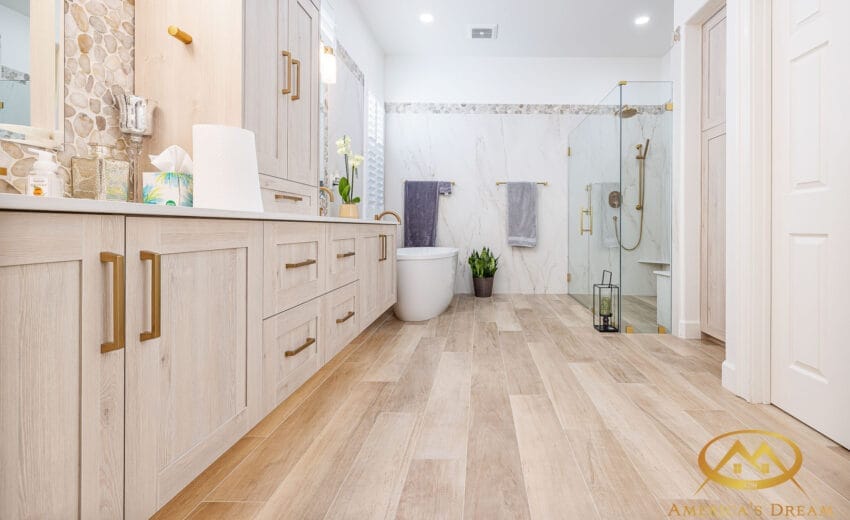Floors are the foundation of any room, setting the tone for the rest of the space, and nowhere is this more true than in the kitchen! The kitchen is not only a functional space but often the heart of the home where families gather, meals are prepared, and memories are made. With so many options available, choosing the best flooring for your needs can feel overwhelming. That’s where this guide comes in—to help you navigate your decision-making process for new kitchen flooring.
This article will walk you through various kitchen flooring options, helping you understand what will work best for your space and lifestyle. From kitchen vinyl flooring to kitchen floor tiles, this information will help you make an informed decision that complements your design aesthetic while meeting practical needs.
Why Kitchen Flooring Matters
Before diving into specific types of flooring, let’s first discuss why kitchen flooring is so important. The kitchen is a space of constant activity, with foot traffic, spills, and wear and tear. Your flooring must be visually appealing, durable, easy to clean, and comfortable underfoot.
Additionally, your kitchen flooring should match the style and mood of your home. Whether you’re aiming for a sleek, modern look or a cozy, rustic vibe, the flooring will set the tone for the entire kitchen and beyond.
Factors to Consider When Choosing Kitchen Flooring
- Durability: Choose materials that can withstand heavy foot traffic, spills, and the occasional dropped pan.
- Ease of Maintenance: Look for options that resist stains, water damage, and dirt buildup.
- Comfort: Since the kitchen is a high-use area, flooring should be comfortable underfoot, especially if you spend long hours cooking.
- Aesthetic Appeal: Flooring should complement the kitchen’s design and tie into the overall theme of your home.
Best Flooring for Kitchens: What to Look For
From hardwood and laminate to vinyl and tile, there’s something for every style, budget, and lifestyle. The best flooring for the kitchen isn’t necessarily the most expensive option—it’s the one that fits your specific needs. Let’s explore some popular choices.
Kitchen Vinyl Flooring: Affordable, Durable, and Stylish
When clients seek an affordable yet durable option, I often recommend kitchen vinyl flooring. Vinyl has come a long way and now offers a range of stylish and practical options for kitchens. Whether you’re drawn to vinyl plank flooring that mimics hardwood or vinyl tile flooring that replicates ceramic or stone, there’s a vinyl solution for every aesthetic.
Advantages of Kitchen Vinyl Flooring
- Affordability: Vinyl is significantly cheaper than hardwood or stone, making it ideal for budget-conscious homeowners.
- Durability: Vinyl resists scratches, stains, and moisture, making it perfect for kitchens.
- Variety of Styles: Modern vinyl comes in a wide range of designs, from wood-look planks to decorative tiles.
- Ease of Maintenance: Vinyl flooring is incredibly easy to clean and maintain.
- Comfortable Underfoot: Softer than tile or stone, vinyl flooring reduces fatigue during long hours in the kitchen.
Disadvantages
- Lower Resale Value: While vinyl is practical, it doesn’t offer the same resale value as hardwood or stone.
Installation
Many vinyl products feature a click-lock system, allowing for straightforward DIY installation. For a professional finish, consider hiring an expert.
Check Our Recent Projects
Kitchen Floor Tiles: Classic Elegance and Durability
Kitchen floor tiles are a popular choice for their unmatched durability and timeless style. Whether you choose classic ceramic or elegant porcelain, tiles provide a sophisticated look while being easy to maintain.
Advantages of Kitchen Floor Tiles
- Durability: Tile floors withstand heavy traffic, moisture, and heat.
- Water Resistance: Tiles are ideal for wet areas like near sinks or stoves.
- Variety of Designs: From classic ceramic to bold patterns, tiles offer endless design possibilities.
- Easy to Clean: A quick sweep and mop keep tile floors looking pristine.
- Longevity: With proper care, tiles can last a lifetime, making them a smart long-term investment.
Disadvantages
- Hardness: Tile floors can feel hard and cold underfoot, which may be uncomfortable for extended use.
- Grout Lines: Grout requires occasional cleaning to maintain its appearance.
Installation
Tile installation requires precision and expertise. I recommend professional installation to ensure proper cutting, alignment, and grouting for a flawless finish.
Making Your Final Decision
Selecting the best flooring for your kitchen involves balancing aesthetics, functionality, and budget. Consider how much time you spend in the kitchen, how often you entertain, and the type of maintenance you prefer.
Why Vinyl Might Be Right for You
If you’re looking for an affordable, low-maintenance option that offers plenty of style choices, vinyl kitchen flooring is an excellent choice.
Why Tiles Might Be Right for You
For a timeless, elegant look that adds value to your home, kitchen floor tiles are hard to beat.
Conclusion
Whether you’re drawn to the practicality of vinyl or the elegance of tiles, your choice of kitchen flooring will significantly impact the look and functionality of your space. High-quality flooring not only enhances your kitchen’s design but also increases the overall value of your home.
Take the time to evaluate your needs, style preferences, and budget to make an informed decision. With the right flooring, you’ll create a kitchen that’s both beautiful and practical—a true heart of the home.
















